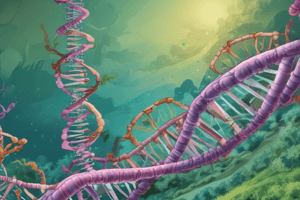Podcast
Questions and Answers
What is the structure of Deoxyribonucleic acid (DNA)?
What is the structure of Deoxyribonucleic acid (DNA)?
Double helix composed of 2 chains that coil around each other
Which of the following describes the Watson-Crick Model of DNA?
Which of the following describes the Watson-Crick Model of DNA?
- Right-handed double helix (correct)
- Interaction of purine and pyrimidine bases (correct)
- Antiparallel orientation of DNA strands (correct)
- Base pairing of nucleobases (correct)
What is the function of genes?
What is the function of genes?
Encode for specific functions or proteins
Define Genome.
Define Genome.
Human cells contain 46 chromosomes.
Human cells contain 46 chromosomes.
Flashcards are hidden until you start studying
Study Notes
Biotechnology
- Biotechnology course outline covers introduction to biotechnology, fundamental principles, genetic engineering techniques, omics sciences, and biotechnology applications.
Fundamental Principles of Biotechnology
- DNA (Deoxyribonucleic acid) is a molecule composed of two chains that coil around each other to form a double helix.
- Rosalind Franklin obtained images of DNA using X-ray crystallography in 1953, allowing James Watson and Francis Crick to create the famous double-helix model.
Watson-Crick Model of DNA
- The DNA structure consists of a right-handed double helix.
- The hydrophilic backbone of alternating deoxyribose and phosphate groups faces outwards and interacts with H2O.
- Purine and pyrimidine bases are hydrophobic and stacked inside the double helix, stabilized by hydrophobic interactions and perpendicular to the long axis.
- Base pairing occurs due to hydrogen bond interactions, where a purine pairs with a pyrimidine (A-T and C-G).
- A and G are long (double-ring purines), while C and T are short (single-ring pyrimidines).
- Each base pair needs one long and one short nucleotide.
- C-G has three hydrogen bonds, while A-T has two hydrogen bonds.
- DNA strands interact in an antiparallel orientation with complementary sequences.
- The stacked bases are 3.4 Å apart.
- The base pairing of the two strands creates a major groove and a minor groove on the surface of the duplex.
Gene and Genome
- A gene is a stretch of information in the sequence that encodes for a particular function (usually a protein or RNA sequence).
- There are approximately 20,000 genes in humans.
- Genes are typically 1000s of nucleotides long.
- Genes can be expressed (used to make proteins) or repressed (not used).
- Regions of DNA are divided into coding and non-coding segments, with over 50% of human DNA being non-coding.
- The complete set of genes or genetic material present in a cell or organism is called the genome.
- In bacteria, the genome is usually circular.
- The genome in eukaryotes is organized into chromosomes.
- Each chromosome is a separate DNA molecule.
- Human cells contain 46 chromosomes (23 each from mother and father).
- Chromosomes are extended and replicated during interphase, and condensed during cell division.
- DNA wraps around protein "spools" to form nucleosomes.
- Nucleosomes are made of histone proteins.
Studying That Suits You
Use AI to generate personalized quizzes and flashcards to suit your learning preferences.




